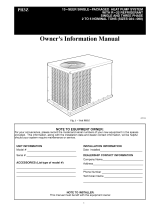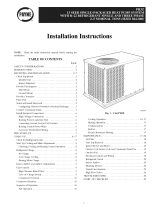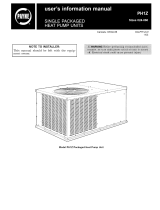Page is loading ...

Owner's Information Manual
Fig. 1 - Unit PH3Z
A05194
NOTE TO EQUIPMENT OWNER:
For your convenience, please record the model and serial numbers of your new equipment in the spaces
provided. This information, along with the installation data and dealer contact information, will be helpful
should your system require maintenance or service.
UNIT INFORMATION
Model #
Serial #
ACCESSORIES (List type of model #)
INSTALLATION INFORMATION
Date Installed
DEALERSHIP CONTACT INFORMATION
Company Name
Address
Phone Number
Technician Name
NOTE TO INSTALLER:
This manual must be left with the equipment owner.

SAFETY CONSIDERATIONS
Installation and servicing of this equipment can be hazardous due
to mechanical and electrical components. Only trained and
qualified personnel should install, repair, or service this equipment.
Untrained personnel can perform basic maintenance functions such
as cleaning and replacing air filters. All other operations must be
performed by trained service personnel. When working on this
equipment, observe precautions in the literature, on tags, and on
labels attached to or shipped with the unit and other safety
precautions that may apply.
Follow all safety codes. Installation must be in compliance with
local and national building codes. Wear safety glasses, protective
clothing, and work gloves. Have fire extinguisher available. Read
these instructions thoroughly and follow all warnings or cautions
included in literature and attached to the unit.
Recognize safety information. This is the safety-alert symbol /_
When you see this symbol on the unit and in instructions or
manuals, be alert to the potential for personal iniury.
Understand these signal words: DANGER, WARNING, and
CAUTION. These words are used with the safety-alert symbol.
DANGER identifies the most serious hazards which will result in
severe personal iniury or death. WARNING signifies hazards
which could result in personal iniury or death. CAUTION is used
to identify unsafe practices which may result in minor personal
iniury or product and property damage. NOTE is used to highlight
suggestions which will result in enhanced installation, reliability,
or operation.
NOTE: Installer: This manual should be left with the equipment
user.
ELECTRICAL SHOCK AND OPERATION HAZARD
Failure to follow this warning could result in personal
injury, death or property damage.
Do not use this unit if any part has been underwater.
Immediately call a qualified service technician to inspect the
unit and to replace any part of the control system which has
been underwater.
WELCOME TO EFFICIENT YEAR-
ROUND COMFORT
Congratulations on your excellent choice and sound investment in
year-round home comfort!
Your new heat pump represents both the latest in engineering
development and the culmination of many years of experience
from one of the most reputable manufacturers of comfort systems.
Your new unit is among the most energy-efficient and reliable heat
pump products available today. To assure its dependability, spend
just a few minutes with this booklet now to learn about the
operation of your heat pump, and the small amount of maintenance
it takes to keep it operating at its peak efficiency. With minimal
care, your new heat pump will provide you and your family with
year-round home comfort-both now and for years to come.
YOUR COMFORT SYSTEM
A. Identifying Your System
Take the time to familiarize yourself with your packaged heat
pump type of system. This knowledge will be of use in
understanding the basic operation of your new heat pump. The unit
has a rating plate affixed to it which provides necessary
information for specific identification of a unit. You should
familiarize yourself withe the product, model, and serial numbers
listed on each rating plate. Record them for future reference in the
space provided at the beginning of this booklet.
IMPORTANT FACTS
To better protect your investment and to eliminate unnecessary
calls, familiarize yourself with the following facts:
1. Your heat pump system should never be operated without a
clean air filter properly installed. Plan to inspect the filter
periodically. A clogged air filter will increase operating
costs and shorten the life of the unit.
2. Supply air and return air registers should not be blocked.
Drapes, furniture, and toys are some of the items commonly
found obstructing registers. Restricted airflow lessens the
unit's efficiency and life span.
3. The outdoor unit must have unrestricted airflow. Do not
cover the unit, lean anything against it, or stand on it. Do
not allow grass clippings, leaves, or other debris to accunm-
late around on top of the unit. Maintain a 30-in. minimum
clearance between the outdoor unit and tall grass, vines,
shrubs, etc.
4. Your multipurpose indoor thermostat is the control center
for your heat pump system. You should familiarize yourself
with its proper operation. Attempting to control the system
by other means-for instance, switching the electrical supply
power ON and OFF - may cause damage to the unit.
5. During heating, increasing the thermostat setting more than
2°F may cause the supplemental heaters to be turned on for
a short period of time to satisfy the thermostat. Needless use
of the supplementary heat reduces potential energy savings.
6. You may find that you can maintain greater personal
comfort by running the fan continuously. "Air pockets" can
form due to the structure of the house, placement of
registers, etc. air pockets nay be tool cool or warm for your
liking. Continuous fan operation minimizes any temperature
differences. Also, systems equipped with electronic or
mechanical air cleaners and/or humidifiers offer the added
benefits of having the air continuously cleaned year-round
and humidified during the winter season.
7. Your heat pump will remove humidity from your home
during the cooling season. After a few minutes of operation,
you should be able to see water trickle from the condensate
drain. Check this occasionally to be sure the drain system is
not clogged. Of course, don't expect to see much drainage if
you live in a very dry environment.
8. During the heating cycle, air from your registers may seem
cooler than you might first expect. This is because your heat
pump delivers a constant flow of air at around 90°F to
105°F instead of sudden bursts of hot air as with a conven-
tional furnace. This air may feel cooler because it is slightly
less than your skin temperature. However, it is sufficiently
warm to keep you comfortable.
9. Ice or frost will tend to form on the coil during the winter
heating operation. Your heat pump is designed to automatic-
ally melt the ice. When in this defrost cycle, it is normal for
steam or fog to rise from the outdoor unit. Do not be
alarmed!
10. Do not operate your unit in cooling mode when outdoor
temperatures are below 55°F (12.8°C) unless your unit was
modified for low-ambient operation.
11. Do not operate your unit in heating mode when outdoor
temperatures are above 66°F (18.9°C) unless you set your
thermostat to emergency heat mode.
OPERATING YOUR HEAT PUMP
The operation of your heat pump system is controlled by the
indoor thermostat. You simply adjust the thermostat and it
maintains the indoor temperature at the level you select. Most
thermostats for heat pump systems have 3 controls: a temperature
control selector, a FAN control, and a SYSTEM or MODE control.

B. Cooling Mode
When operating in cooling mode, your heat pump will run in
cooling mode until the indoor temperature is lowered to the level
you have selected. On extremely hot days, your heat pump will run
for longer periods at a time and have shorter "oft_' periods than on
moderate days.
The following are typical conditions that add extra heat and/or
humidity to your home. Your heat pump will work longer to keep
your home comfortable under these conditions:
1. Entrance doors are frequently opened and closed.
2. Laundry appliances are being operated.
3. A shower is running.
4. More than the usual number of people are present in the
home.
5. More than the normal number of lights are in use.
6. Drapes are open on the sunny side of the home.
C. Heating Mode
With the SYSTEM or MODE control of your indoor thermostat set
to HEAT, your heat pump will run in heating mode until room
temperature is raised to the level you have selected. Of course, your
heat pump will have to operate for longer periods to maintain a
comfortable environment on cooler days and nights than on
moderate ones.
D. Defrost Mode
When your heat pump is providing heat to your home and the
outdoor temperature drops below 45°F (7.2°C), moisture may
begin to freeze on the surface of the coil. If allowed to build up,
this ice would impede airflow across the coil and reduce the
amount of heat absorbed from the outside air. So, to maintain
energy-efficient operation, your heat pump has an automatic
defrost mode. The defrost mode starts at a present time interval of
60 minutes. Defrost will start at the preset time only if the ice is
sufficient to interfere with normal heating operation. After the ice
is melted from the coil, or after a maximum of 10 minutes in
defrost mode, the unit automatically switches back to normal
heating operation.
Do not be alarmed if steam or fog appears at the outdoor unit
during defrost mode. Water vapor from the melting ice may
condense into a mist in the cold outside air. During certain weather
conditions such as heavy snow and freezing rain it is not
uncommon for ice to build up on the unit grille. This is normal for
these weather conditions. Do not attempt to remove the ice from
the unit grille. This condition will not affect the proper function of
the unit and will clear a few days.
E. Emergency Heat Mode
This allows your supplemental heating source to keep your home
or office warm until your heat pump can be serviced. Also, if the
electricity to your heat pump has been off for more than 30
minutes, switch your thermostat to EHEAT mode before restarting
your heat pump. Leave the system in EHEAT mode for an amount
of time equal to the power outage. It is not necessary to exceed 12
hours. (If you cannot determine how long the power has been off,
leave the system in EHEAT mode for 8 hours.)
PERFORMING ROUTINE MAINTENANCE
With the proper maintenance and care, your heat pump will operate
economically and dependably. Maintenance can be accomplished
easily by referring to the following directions. However, before
performing maintenance, consider these important safety
precautions:
FIRE, EXPLOSION, ELECTRICAL SHOCK AND
CUT HAZARD
Failure to follow this warning could result in personal
iniury, death or property damage.
1. TURN OFF ELECTRICAL POWER TO YOUR UNIT
BEFORE SERVICING OR PERFORMING
MAINTENANCE.
2. When removing access panels or performing
maintenance functions inside your unit, be aware of
sharp sheet metal parts and screws. Although special care
is taken to reduce sharp edges to a n_ininmm, be
extremely careful when handling parts or reaching into
the unit.
ELECTRICAL SHOCK AND CUT HAZARD
Failure to follow this warning could result in personal
iniury, death or property damage.
When removing access panels or performing maintenance
functions inside your unit, be aware of sharp sheet metal
parts and screws. Although special care is taken to reduce
sharp edges to a n_ininmm, be extremely careful when
handling parts or reaching into the unit.
F. Check the Air Filter
[]NIT OPERATION HAZARD
Failure to follow this caution may result in property
damage.
Never operate your unit without filters in place. An
accumulation of dust and lint on internal parts of your unit
can cause loss of efficiency.
A dirty air filter will cause excessive strain on the compressor and
blower motor. This can cause the components to overheat and
automatically shut down. In the worst case, the components will
fail and need to be replaced. To avoid inefficient or failed operation
of your unit, CHECK THE FILTER(S) EVERY 3 OR 4 WEEKS.
Replace filter(s) when necessary, or clean the filter(s) if you have
the reusable type.
Disposable filter should be replaced by similar, new filters of the
same dimensions.
Reusable, permanent filters should be washed in a solution of cold
water and mild detergent, then rinsed and thoroughly dried. THE
FILTER MUST BE COMPLETELY DRY BEFORE BEING
REINSTALLED. To avoid prolonged shutdown of your unit while
a filter is drying, you should have an extra filter on hand. This
allows you to rotate between the two with minimal downtime for
your comfort system. Extra filters may be purchased from your
dealer.
The filters(s) and filter rack for a packaged system are supplied and
installed by the contractor or dealer. Typically, the filter(s) and rack
are located in the return air duct ant the outdoor unit or behind the
return air grille(s). Have your dealer show you the location of your
filter(s) and the procedures for removal and replacement.
If your system includes a high efficiency or electronic air cleaner,
refer to air cleaner User's Manual for proper filter cleaning or
replacement.

TableI -Indoor Air Filter Data
Unit Size Filter Size
024-066 24x24xl (610x610x25 mm)
042-060 30x60x1 (762x762x25 mm)
G. Outdoor Coil
If grass clippings, leaves, shrubbery, and debris are kept away form
the unit, minimal care should be sufficient to keep the system
functioning properly. However, if the outdoor coil becomes dirty,
use a vacuum cleaner or shop vac with soft brush attachment to
clean the exterior surface. Vacuum coil surface using an up and
down motion. De careful not to bend or damage fins.
If dirt is deep in the coil, contact your dealer for service. Do not
attempt this yourself.
PERSONAL INJURY AND UNIT DAMAGE
HAZARD
Failure to follow this warning could result in personal
iniury, death or property damage,
Do not insert sticks, screwdrivers, or any other object into
revolving fan blades,
H. Outdoor Coil--Sea Coast
If your unit is located near the ocean, special maintenance is
required. Ocean mistA_reeze carries salt, which is corrosive to most
metals. Although your new unit is made out of galvanized metal
and is protected by top-grade paint, you should take the precaution
of additional maintenance which consists of periodically washing
the unit. By washing all exposed surfaces and coil, you will be
adding additional life to your unit. Please consult your installing
contractor for proper intervals/procedures for your geographic area
or service contact.
I. Unit Support
Your packaged heat pump unit should be maintained at a level
position. If its support should shift or settle so that the unit is no
longer level, you should correct the condition. Relevel it promptly
to assure water drains out of the unit. If you notice that water or ice
collects beneath the unit, arrange for it to be drained away form the
unit.
BEFORE YOU REQUEST A "SERVICE
CALL" CHECK FOR THESE EASILY
SOLVED PROBLEMS
1. Check the indoor and outdoor disconnect switches. Verify
that circuit breaker are ON or that fuses have not blown.
2. Check for sufficient airflow. Check the air filter(s) for any
accumulations of dirt. Check for blocked return air or
supply air registers. Be sure registers are open and unob-
structed.
3. Check the settings on your indoor thermostat. If you desire
cooling, make sure that the temperature control selector is
set below room temperature and the SYSTEM or MODE
control is set to COOL or AUTO. If you require warmth,
make sure that the temperature control selector is set above
room temperature and the SYSTEM or MODE control is set
to HEAT or AUTO. The FAN control should be set to ON
for continuous blower operation or AUTO if you wish
blower to function only while your heat pump is operating.
If your comfort system still fails to operate, turn your
system off and contract your servicing dealer for
troubleshooting and repairs. Specify your apparent problem,
and state the model and serial number of your equipment.
(You should have them recorded on the first page of this
booklet.) With this information, your dealer may be able
offer helpful suggestions over the phone or save valuable
time through knowledgeable preparation for the service call.
REGULAR DEALER MAINTENANCE
In addition ot the routine maintenance that you perform, your
mode comfort system should be inspected regularly by a properly
trained service technician. The inspection (preferably twice each
year, but at least once every year) should include the following:
1. Routine inspection of air filter(s). Replacement or cleaning
as required.
2. Inspection and cleaning of the blower wheel, housing, and
motor as required.
3. Inspection and, if required, cleaning of coils.
4. A check of all electrical wiring and connections.
5. A check for secure physical connections of individual
components within unit.
6. Operational check of the heat pump system to determine
actual working condition. Necessary repair and/or adjust-
ment should be performed at this time.
7. Your servicing dealer may offer an economical service
contract that cover seasonal inspections. Ask for further
details.
Warranty Certificate
Your PH3Z unit has a limited warranty. Be sure to read the
warranty carefully to determine the coverage for your unit.
In Case of Trouble
If you perform the steps above and unit performance is still
unsatisfactory, shut off the unit and call your dealer.
'?2008 Payne Heating & Cooling Systems • 7310 W, Morris St. • Indianapolis, IN 46231 Printed in U,S,A, Edition Date: 04/08
Manufacturer reserve8 the right to change, at any time, specification8 and design8 without notice and without obligations,
Catalog No: OG-PH3Z-02
Replaces: OG- PH3Z-01
/





